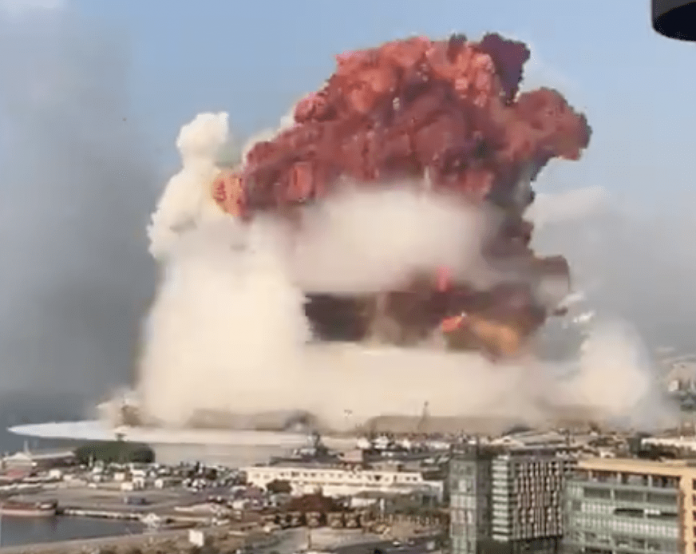Deadliest fires or explosions in the world
Excluding bombings and wartime attacks
| Rank | Event | Date | Number of deaths |
| 1 | Earthquakes resulted in fires that caused most deaths [1] Tokyo to Yokohama, Japan |
September 1, 1923 | Most of 142,807 total deaths |
| 2 | Earthquake resulted in fires that caused most deaths [1] Tokyo, Japan |
March 21, 1857 | Most of 107,000 total deaths |
| 3 | Nuclear power plant chemical explosion led to release of nuclear radiation [2] Kiev, U.S.S.R. |
April 26, 1986 | 31 immediate deaths plus 7,000-8,000 deaths of exposed clean-up workers |
| 4A | Urban conflagration [5] Constantinople (now Istanbul) Turkey |
1729 | 7,000 deaths |
| 4B | Fire [6] Chiangking, China |
September 3, 1949 | 7,000 deaths |
| 6 | Pesticide plant explosion released deadly chemical fumes [3] Bhopal, India |
December 3, 1984 | 3,849 deaths by chemical fumes |
| 7 | Uranium mine explosions [1, 6] Johanngeorgendstadt, East Germany |
November 29, 1949 | 3,700 deaths |
| 8 | Gunpowder explosion in arsenal [5] Brescia, Italy |
1769 | 3,000+ deaths |
| 9 | Office buildings collapsed due to fire started when airlines were flown into upper floors [4] New York, New York, USA |
September 11, 2001 | 2,749 civilian and firefighter deaths |
| 10 | Riverfront conflagration. Reported as separate from #4B, which occurred the next day [5, 6] Chungking, China |
September 2, 1949 | 1,700 deaths |
| 11 | Theater fire [3] Canton, China |
May 3, 1845 | 1,670 deaths |
| 12 | Munitions ship explosion after collosion with relief ship [3] Halifax, Nova Scotia, Canada |
December 6, 1917 | 1,654 deaths |
| 13 | Coal mine explosion [6] Honkeiko, Manchuria, China |
February 12, 1931 | 1,549 deaths |
| 14 | Steamship explosion Mississippi River, USA |
April 27, 1865 | 1,547 deaths |
| 15 | City fire/conflagration [5, 6] Hakodate, Japan |
March 21, 1934 | 1,500 deaths |
| 16 | Church fire [1] Santiago, Chile |
December 8, 1863 | 1,488-2,500 deaths |
| 17 | Forest fire [4] Peshtigo, Wisconsin, USA and environs |
October 8, 1871 | 1,152 deaths |
| 18A | Dynamite truck explosion [3, 4] Cali, Columbia |
August 7, 1956 | 1,100 deaths |
| 18B | Refugee steamship explosion [5, 6] East China Sea |
December 3, 1948 | 1,100 deaths |
| 20 | Coal mine explosion [1, 6] Courrieres, France |
March 10, 1906 | 1,060 deaths |
| 21 | Steamship boiler explosion [4] New York, New York, USA |
June 15, 1904 | 1,030 deaths |
| 22 | Fire spread from street market to army weapons depot, which suffered series of explosions [2] Lagos, Nigeria |
January 27, 2002 | 1,000+ deaths |
| 23 | Gunpowder storehouse explosion [5, 6] Salonika, Greece |
August 4, 1898 | 1,000 deaths |
Note: These are incidents known to NFPA from the sources cited and deemed to fit within the eligibility parameters, based on best available information. Terrorist incidents using explosives are excluded, but other terrorist incidents are not treated as wartime incidents and are not excluded. Incidents involving warships but not arising from conflict are not excluded.
Sources:
[1] Lee Davis, Man-Made Catastrophes, Facts on File, New York, 1993
[2] United Nations articles and reports
[3] The World Almanac 2003
[4] Fires in NFPA’s Fire Incident Data Organization (FIDO).
[5] James Cornell, The Great International Disaster Book, Pocket Books, New York, 1976.
[6] Various history websites.
Notes on excluded incidents with conflicting information: Several incidents would be eligible based on death tolls cited in some sources but are not included based on lower death tolls cited in what were deemed to be more reliable sources. A 2004 North Korea fuel train collision, explosion and fire has reported death tolls ranging from just over 100 to 3,000, with most sources citing the former, lower figure. The 1982 Salang Tunnel, Afghanistan fire has death tolls reported from 150 to 3,000, with less than 200 deaths apparently confirmed. A 1755 Lisbon, Portugal earthquake with 50,000 total deaths was said by one source to have had “thousands” of fire deaths within the total. An 1856 gunpowder explosion that destroyed a church on the Island of Rhodes, Greece, was said to have involved 4,000 deaths in one source but 800 deaths in another source. One source cites a munitions explosion in Bombay, India, 1944, as involving over 1,300 deaths but most sources put the death toll at 800 or less. One source cites a munitions ship explosion in a Russian harbor in 1917, killing 1,500, but it is not clear whether this was a wartime attack, occurring during World War I. The same source cites a 1946 naval ship fire in Haiphong Harbor, Vietnam, killing 6,000, but does not indicate whether this was due to a wartime attack.
Disclaimer: Death tolls are based on information in NFPA’s records. Please contact us to provide any updated information.





